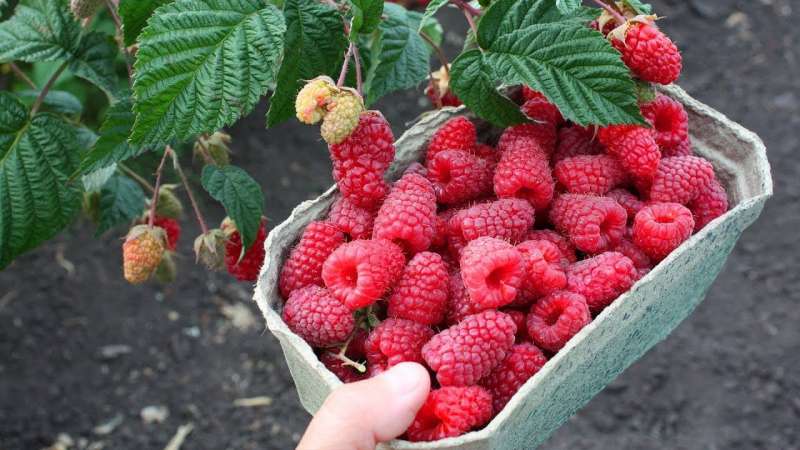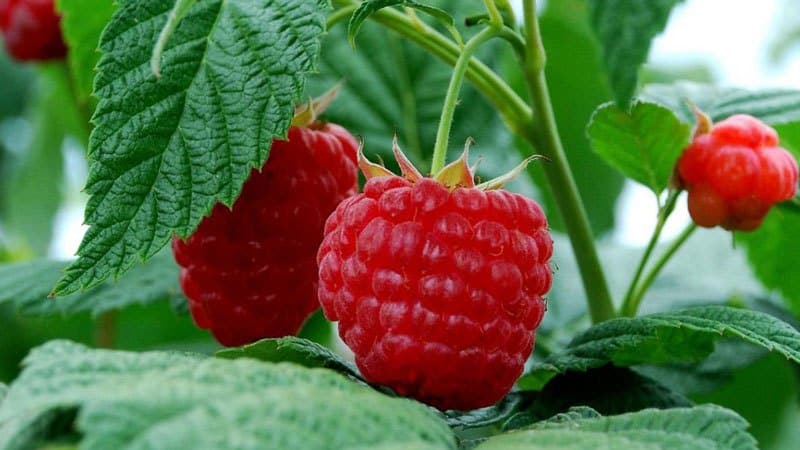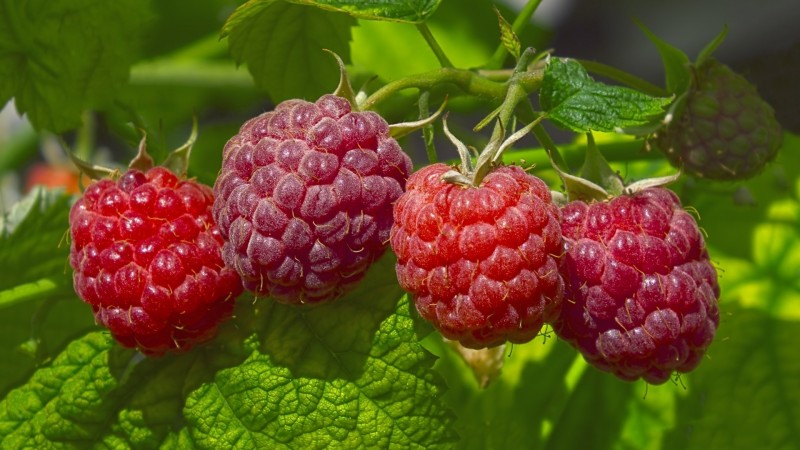Which raspberry varieties are the most productive?
The raspberry patch is one of the most favorite places in the garden. Red and pink berries grow both in the north of the country and in the southern regions. Some gardeners prefer common raspberries, others prefer remontant ones. The main thing is that it is productive, tasty and beautiful. To choose a high-yielding variety of garden raspberries, it is recommended to study the description of the most popular ones.
Which raspberry varieties are the most productive?

Many factors influence raspberry productivity: warm and sunny weather, suitable planting site, fertilization and watering, protection from insects and diseases. The number of fruits collected depends on the choice of variety. Next, we will consider the most productive varieties raspberries, their advantages and features.
Sweet
Both adults and children love sweet raspberries. Berries with delicate and soft pulp melt in your mouth and are refreshing on a hot summer day. Delicious and sugary fruits are indispensable for preparing winter preparations. Raspberry jam is a folk remedy for protecting against flu and colds, strengthening the immune system. Compotes, jams and jellies are also made from berries.
Hercules
Remontant variety universal purpose. Bushes of medium vigor, slightly spreading, 1.5-2 m high. Shoots are brown, straight, medium thorny. The leaves are large, green, slightly wrinkled. The berries are red, weighing about 6 g, the pulp is aromatic and sweet. Raspberries Hercules are valued for their strong immunity - the plant is rarely affected by gray rot or powdery mildew. Productivity - up to 4 kg of raspberries per bush.The berries ripen in mid-August, the fruiting period continues until the first frost. The variety is recommended for planting in the Central region.
Yellow giant
Mid-early dessert variety. The ripening period begins in mid-July and continues until autumn. The bushes are medium-sized, 2-2.5 m high. Medium thorns are located throughout the shoot. The flowers are large, so the bush looks especially beautiful during flowering. The weight of the berry is 1.7-31.1 g, the shape is blunt-conical. The color is amber-yellow, attractive, with slight pubescence. The taste is delicate and pleasant, sweet, the aroma is rich berry and fruit. Productivity - 4-6 kg of berries per bush. The purpose is universal - raspberries are suitable for fresh consumption and processing.
Caramel
The mid-early ripening Caramel raspberry is suitable for cultivation in all regions of the country. The bushes are medium-sized, straight-growing. The number of thorns is medium, the leaves are dark green, twisted. The weight of the berry varies from 3.8 to 8 g, the shape is wide-conical, the color is red and shiny. The pulp is sweet and aromatic. The variety is remontant and produces about 5 kg of raspberries per bush per season. Resistance to heat and drought is average, frost resistance - down to -26°C. Caramel is grown for personal consumption and sale - the berries are transportable and do not spoil during transportation.
With large fruits
Large-fruited raspberry - a godsend for any gardener. To obtain a rich harvest, summer residents apply mineral and organic fertilizers throughout the growing season - they stimulate the growth of fruits and protect them from cracking and rot.

Patricia
This variety, unpretentious in cultivation, is characterized by stable fruiting - summer residents harvest 5-8 kg of berries over the summer. The bushes are spreading, about 1.8 m high. The berries ripen from mid-July to mid-August.The shape is cylindrical, the color is red-pink, there is velvety pubescence. The weight of the fruit is 6-12 g, the pulp is of a delicate consistency, dense, the taste is sweet and aromatic. Semyan there is little in the fruit. Raspberry Patricia is intended for fresh consumption, as it does not tolerate transportation well. The crop is grown in the Central region and in the Urals.
Tarusa
Standard variety of late ripening. Tarusa raspberries are compact, no more than 1.8 m high, with thick shoots, so they are suitable for planting in small garden plots. There are no thorns in care does not require special agrotechnical skills. The berries are burgundy with a red tint, weighing 10-15 g, conical in shape. The taste is sweet and sour, the flesh is dense, the aroma is rich. The yield of the Tarusa variety is from 4 to 6 kg of raspberries per bush. Resistance to diseases and pests is above average. It is universal in use - jam, juices, and confitures are prepared from the fruits.
Interesting! Elastic berries are used for storage. They are removed from the bush, placed in 2 rows in plastic containers, covered with a clean napkin and put in the refrigerator. You cannot wash berries for storage, otherwise they will quickly spoil. Fresh raspberries can be stored in a cool place for no more than 10 days.
Early
Early varieties grown mainly in central Russia, in the Urals and Siberia. With proper care, the harvest is harvested in June. Early raspberries are unsuitable for storage and transportation; gardeners use them for cooking or eat them fresh.

Kuzmina News
The bushes are erect, 2-2.5 m high, and begin to bear fruit in mid-June. The shoots are slightly spiny, the flowers are large and white. The leaves are medium sized, dark green. Fruit weight - 2-4 g, classic crimson color, conical shape.The taste is sweet and aromatic, pleasant. Tasting score - 5 points. News Kuzmin is valued for its frost resistance, ease of care and strong immunity. Productivity - from 2 to 4 kg per bush. Disadvantages include the lack of transportability and shelf life.
Lyashka
The variety of Polish selection is distinguished by early ripening and early maturity. In the middle zone it bears fruit from mid-June to the end of July. The bushes are erect, no more than 2.5 m high. Brown shoots are covered with a weak waxy coating and short green thorns. The berries are matte, dark red, weighing 4-10 g. The shape is conical, elongated, the flesh is dense, the aroma is pleasant. The taste is sweet, raspberry. The variety is winter-hardy and drought-resistant, yield is 5 kg per plant. The berries are transportable and have a universal purpose. For the winter, Lyashka raspberries require shelter.
Sun
The early ripening variety Solnyshko is resistant to anthracnose and root rot, and is rarely damaged by mites. The height of the spreading bush is about 2 m, the shoots are strong, the thorniness is weak. The berries are round-conical, weighing 3.5-4.5 g, burgundy-raspberry color, matte. The taste is sweet, tasting score - 4.3 points. Raspberry Solnyshko is suitable for all types of processing. Productivity is from 2 to 4 kg of berries per bush.
Mid-season
Mid-season varieties ripen in the second decade of July, fruiting continues until autumn. The fruits are often grown for commercial purposes - for transportation and sale. Due to the longer ripening period, mid-season raspberries need a balanced diet, so summer residents add potassium salt, superphosphate, and urea to the soil.

Red Rain
The variety is winter-hardy, resistant to purple spot and spider mites.The bushes are low and spreading, so support in the form of a trellis or wooden peg is required. The weight of the berry is 3 g, the shape is blunt-conical, the color is raspberry. The taste is sweet with sourness, the aroma is pleasant. Tasting score: 4.3 points. The yield of Red Rain is stable - the bush produces about 3 kg of berries per season. The plant does not tolerate waterlogging and is demanding on the composition of the soil - it prefers a mixture of loamy and sandy loam soil. The distance between seedlings should be at least 2 m.
Rubin Bryansky
The Rubin Bryansky variety, unpretentious to grow, is suitable for the Central and North-Western regions. The bush is highly spreading and quickly adapts to the climatic conditions of the region. Annual shoots are covered with a waxy coating. There are few thorns, the leaves are dark green, slightly wrinkled. The berries are blunt-conical in shape, rich ruby color, fruit weight - 6 g. The pulp is sweet and tender, with an aroma. Tasting score: 4.5 points. About 3 kg of fruits are harvested from one plant per season. The berries are processed or eaten fresh.
Bell
The Bell variety is drought and frost resistant and is slightly affected by powdery mildew and purple spot. The bushes are medium-sized and spreading, shoots with weak thorns, green. The weight of the berry is about 3 g, the shape is conical, the color is red-pink. The taste is sweet and sour, balanced. After ripening, the Bell does not crumble or crack, and is universal in use. Seedlings prefer well-lit areas with light soil. Productivity - 2-4 kg of fruits per bush.
Late
Late raspberries are planted in regions with warm and long summers, for example, in the Krasnodar Territory.In 3-4 months, the berries grow juicy and large, they are used for sale, transportation, transportation, personal consumption, and processing. Varieties are distinguished by their immunity to diseases and common insect pests.

Indian summer
The remontant variety ripens in the second ten days of August. The bush is erect and slightly spreading, height - 1-1.5 m. The thorns are large and hard, the shoots are of medium thickness with a waxy coating. The leaves are smooth, slightly wrinkled. The berries are truncated conical, weighing 2-3 g. The color is red, attractive, the taste is sweet and sour. The tasting rating of the variety is 4.5 points. The plant is unpretentious in cultivation, which especially attracts amateur gardeners or beginners. Fresh raspberries are suitable for freezing, cooking, and canning. Indian summer is grown in the Kuban and Crimea.
Diamond
A remontant universal variety is grown in the south and central region. Bushes of medium vigor, brown, medium thorniness. The berries are large, conical in shape, ruby red, glossy in color. The pubescence of the berries is weak, the seeds are large. Berry weight is 8-12 g, yield is about 3 kg per bush. The pulp is sweet and sour, without aroma. Tasting score - 4 points. Diamond bears fruit from the second ten days of August until the onset of frost.
Attention! It is recommended to plant medium-sized bushes using the trench method. Summer residents dig beds 45 cm deep and 50 cm wide, leaving a distance of 1 m between rows. Fill the hole with a mixture of manure, soil and double superphosphate. After planting, the seedlings are watered with warm water and mulched.
New high-yielding raspberry varieties

Among the new varieties, summer residents note Erika and Marastar raspberries.
Erika - remontant variety of Italian selection.The weight of the berry is about 7 g, the shape is elongated, the color is bright red. The taste is sweet and sour with a rich raspberry aroma, pleasant. The height of the bush is about 2 m, the shoots are strong and powerful, the thorniness is below average. The leaves are bright green, medium wrinkled. Erika's winter hardiness is down to -30°C. The yield of an adult plant is 4-5 kg per summer. Summer residents appreciate Italian Erica for its original taste and attractive appearance of the fruit.
Remontant French variety Marastar produces up to 3 kg of ripe berries per season. The height of the bush is 1.6 m, there are few thorns. The weight of the berry is from 6 to 11 g, the shape is conical, the taste is dessert-sweet and sour, with a bright raspberry aroma. The color is bright red, the flesh is tender. Marastar raspberries can be stored for up to 2 weeks and are suitable for transportation. Frost resistance - down to -20°C.
Conclusion
Good yielding varieties of sweet raspberries are Hercules, Caramel, Yellow Giant. The berries are suitable for fresh consumption and processing; jams and jams are prepared from them. Patricia and Tarusa delight summer residents with large and heavy fruits. Early varieties News Kuzmina and Lyashka unpretentious in care, late Diamond and Indian Summer are resistant to diseases and pests. Of the new varieties, Erica and Marastar are noted. They bear fruit consistently, giving juicy and tasty berries.